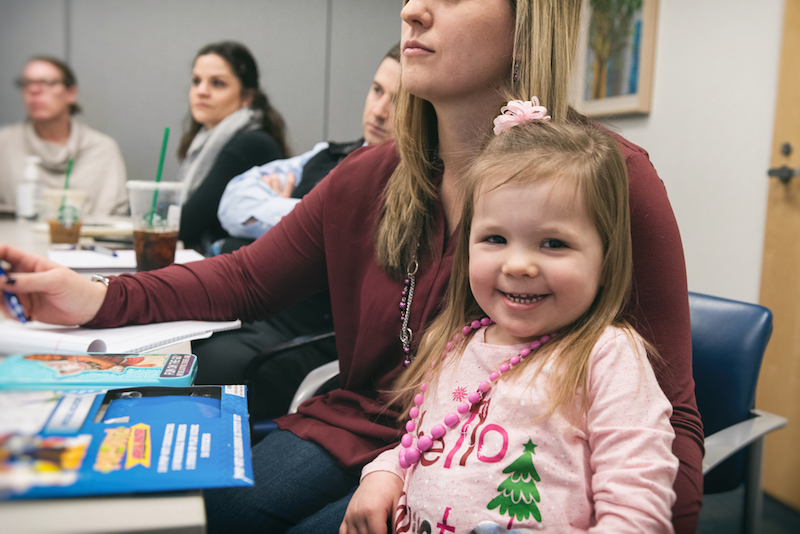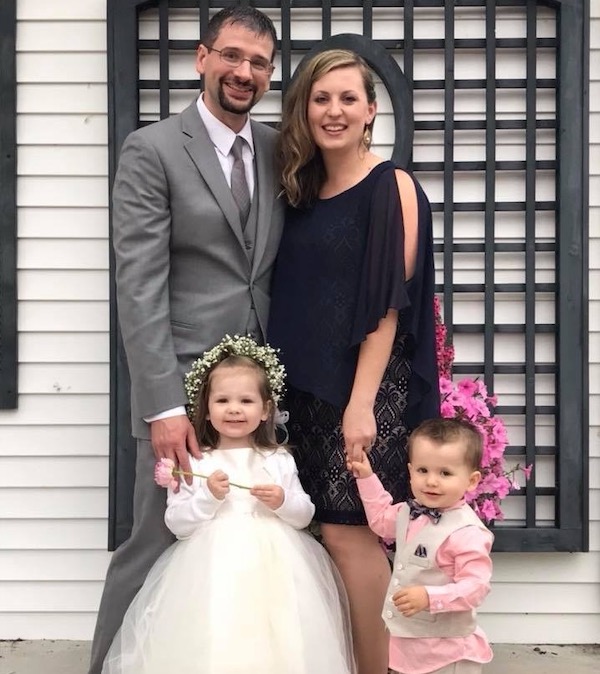Lia the ballerina: Off the couch and onto the stage

No matter what 3-year-old Lia is doing — playing dress-up, singing for her family, or running around with her preschool friends — you can be sure she’ll do it with pizzazz. “She’s a total girly girl,” says her mom, Kaitlyn. “She would wear makeup if I let her!” Watching her jump and twirl, you’d never guess that just a few months ago, this budding ballerina lacked the energy to even get off the couch, never mind dance.
Persistent tummy trouble
When Lia was 2 years old, she started having gastrointestinal symptoms that would flip flop between diarrhea and constipation. Her local pediatrician suggested she wasn’t drinking enough or could be allergic to milk, but increasing fluids and cutting out milk didn’t help.
Kaitlyn and her husband, Dave, brought Lia back and forth to the doctor’s office for months with no improvement. “It was so frustrating,” says Kaitlyn. “We were doing everything we were being told to do to help, but meanwhile Lia was listless and sickly. Her skin was grey and pale.”
Worsening symptoms and a mother’s instinct
Just before Lia’s third birthday, her diarrhea went from bad to worse. The pediatrician diagnosed her with Clostridium difficile or C. diff, an infection that causes debilitating diarrhea.
Yet a full course of prescribed antibiotics did nothing to improve the situation. “At that point, I knew something was wrong with her GI system,” says Kaitlyn. “She just didn’t seem normal.” Lia’s parents had asked for more aggressive testing, to no avail. It was clear that the “wait and see” method was not helping. She wasn’t getting better. They wanted to know the root of the problem.
We had dealt with this for so long and we had exhausted all our options locally.
At Lia’s 3-year-old wellness visit, Kaitlyn finally had proof that things were as serious as she had suspected. Lia hadn’t grown at all in a full year. Then a few months later, she began vomiting every single day. “We didn’t want to go out because we didn’t want to embarrass Lia if she suddenly had to vomit,” remembers Kaitlyn. “Poor thing, when we did venture out, we always carried a bucket for her.”
The pediatrician suggested the vomiting was due to severe constipation, but no matter how Kaitlyn adjusted her diet, Lia would continue to throw up every day.
That was the final straw.
“We had dealt with this for so long and we had exhausted all our options locally. Our pediatrician still didn’t want to do testing and we just didn’t feel like we were being listened to. I asked to be referred to a specialist at Boston Children’s Hospital.”
A diagnosis of celiac disease
“It took one visit to Boston Children’s for us to get answers,” says Kaitlyn. “We are so fortunate to be a half hour away from a place that people from all over the world travel to.”
After an initial meeting with gastroenterologist Dr. Naamah Zitomersky, a stool sample and bloodwork, Lia and her family headed home to wait for the results. The following day, Dr. Zitomersky called to say that Lia’s blood test showed antibodies suggestive of celiac disease. Kaitlyn remembers feeling mostly relieved. “Celiac disease is a lifelong diagnosis, but at least it’s treatable. I admit I was also kind of disappointed, though, that it wasn’t something they could just fix one and done.”
It took one visit to Boston Children’s for us to get answers.
An endoscopy was scheduled to biopsy Lia’s small intestine — an essential step to making a definitive diagnosis. “We had to keep giving her gluten for three weeks, knowing it was basically poisoning her, so they could perform the test accurately,” says Kaitlyn. “That was torture.”
Dr. Zitomersky explains, “It is important for us to see the tissue changes associated with celiac disease, as well as grade the severity of the disease by looking at these biopsies under the microscope. If people initiate a gluten free diet prior to endoscopy, this can make the biopsy results falsely negative because the intestine begins to heal when we remove gluten from the diet. We want to be confident in the diagnosis.”
The day of Lia’s endoscopy was the same day she started on a gluten-free diet.
Off the couch and onto the stage
With 6 months of the new diet under her belt, Lia is now an energetic toddler and a big sister to 2-year-old Bryce. She hasn’t vomited once since cutting out gluten and is growing bigger and stronger every day. Her vibrant color and dramatic dance moves are back. “Her personality has changed 10-fold,” says Kaitlyn. “She has so much — too much — energy.”

While gluten-free chicken nuggets and mac and cheese are staples, Lia also loves fruits and vegetables and is starting to explore more whole foods that Kaitlyn and Dave hope will replace the processed toddler foods as she gets older. At just 3 years old, Lia already understands that gluten makes her sick and that she needs to question anything that goes into her mouth. She knows she gets a special cupcake at preschool celebrations and that Play-dough and macaroni necklaces are off limits.
Meanwhile, Kaitlyn has been busy herself, learning everything she can about celiac disease when she’s not running after Lia. She’s attended a nutrition class at Boston Children’s with a dietician specializing in celiac disease, partnered with Lia’s daycare to keep her safe at school, color-coded their kitchen, learned to pack gluten free foods wherever they go, educated friends and family, and had Bryce tested (he was negative).
She’s not stopping anytime soon, but she’s careful to pace herself. “Dave and I are not experts yet,” Kaitlyn says. “But that’s OK. This is a lifelong journey. We’re making the transition and wrapping our heads around one thing at a time. And we’re also letting ourselves enjoy our happy, healthy girl.”
Learn more about our Celiac Disease Program.
Related Posts :
-

Team spirit: How working with an allergy psychologist got Amber back to cheering
A bubbly high schooler with lots of friends and a passion for competitive cheerleading: On the surface, Amber’s life ...
-

Thanks to Carter and his family, people are talking about spastic paraplegia
Nine-year-old Carter may be the most devoted — and popular — sports fan in his Connecticut town. “He loves all sports,” ...
-

Genetic causes of congenital diarrhea and enteropathy come into focus
Congenital diarrheas and enteropathies are rare and devastating for infants and children. Treatments have consisted mainly of fluid and nutritional ...
-

Genomic sequencing transforms a life: Asa’s story
Asa Cibelli feels like he’s been reborn. The straight-A middle schooler plays basketball and football, does jiu jitsu, is ...





